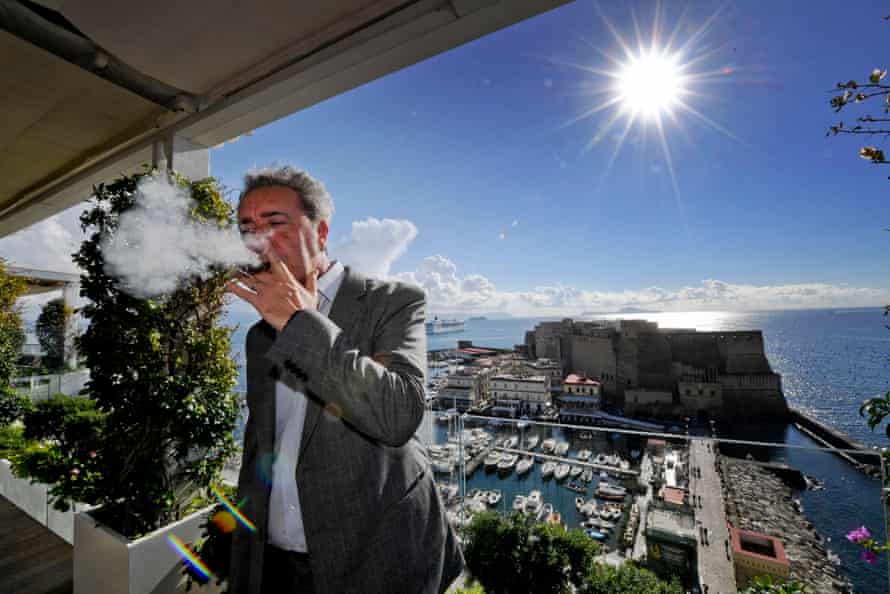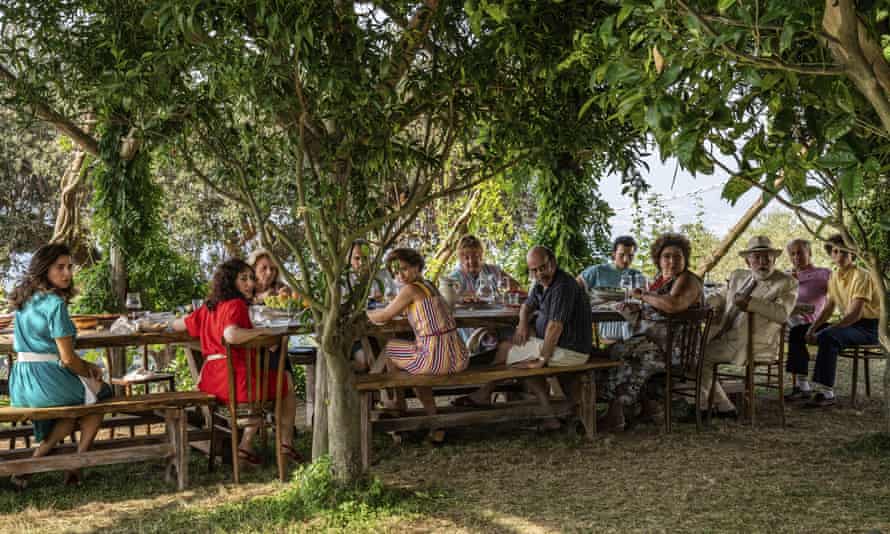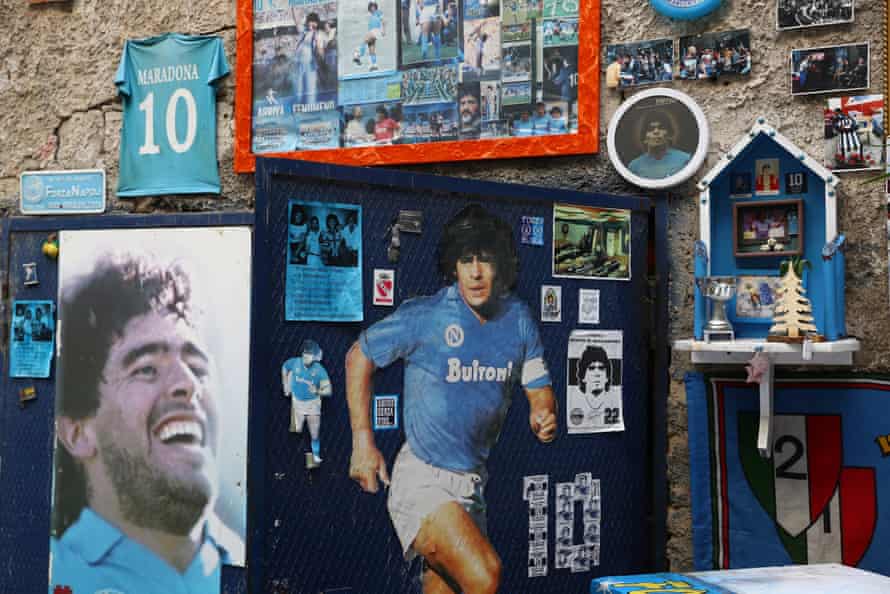‘This, for me, is the most beautiful place on Earth,” Paolo Sorrentino told Filippo Scotti, the actor playing the director’s younger self in his latest film, as their 1980s Riva speedboat chopped the waves of the Bay of Naples. Their view stretched from the precipitous peninsula of Sorrento all the way west towards Posillipo. The two promontories flank the sprawling port city, offering a warm embrace to all those who disembark there. Sorrentino’s new film, the Hand of God, opens with that same view: the sun-mottled bay, whose peace is disturbed by the sound of four Rivas as they speed towards the shore. The film is both a love letter to, and a portal into, Paolo Sorrentino’s Naples.
In cinemas now and on Netflix this week, The Hand of God sees the Academy award-winning director return to his home city for the first time since One Man Up, his 2001 debut. Sorrentino tells the story of his own coming of age, up to the moment when his life is shattered by the death of his parents in a tragic accident. Sorrentino’s story is a tale of great grief, loss and perseverance, set in a middle-class part of Naples, a far cry from the impoverished neighbourhoods shown in the city’s other recent portraits: Elena Ferrante’s My Brilliant Friend or the mafia-focused Gomorrah series.

Following the teenage life of Fabietto Schisa, a teenage Sorrentino-esque figure, the director maps out a rarely seen Naples, and his film serves as a refreshing guide to the city. Unlike the historic centre, with its ancient, working-class character, the Vomero neighbourhood feels more genteel and modern. Perched high above the city, it’s rarely visited by tourists. Nicknamed la città alta (the high city), most of Vomero comprises residential neighbourhoods built in the late 1960s and 70s. Low-rise housing blocks, such as those along Via San Domenico where Sorrentino grew up, envelop the craggy hill as it rises steeply above the sea.
At the heart of Vomero, however, is the Liberty-era Piazza Vanvitelli, an elegant octagonal square lined with cafes. Here the Fabiettos of today spill out of the nearby Istituto Salesiano secondary school Salesian Institute – Sorrentino’s alma mater – gossiping and smoking Camel Blues on benches. Leading off the piazza are wide avenues lined with department stores, bookshops and independent cinemas. In the cross streets are restaurants such as the historic La Gorizia 1916, a Vomero institution that opened during the first world war to help feed the famished neighbourhood, serves a quintessentially Neapolitan menu. Dishes are a step above some of the trattorias in the historic centre, which have begun to lose their way with the influx of tourists. Inhabitants of the lower city make an occasion of going “up” to Vomero, climbing the steep Pedamentina staircase and enjoying the views of the bay from Castel Sant’Elmo at the top.

Viewed from a distance of two decades, Sorrentino’s Naples – as portrayed in the film – is pricked with both melancholy and a rose-tinted nostalgia. From his youth he remembers the Amalfi coast, the vine-laced foothills of the Mount Vesuvius and the Apennines on the city’s doorstep. An early scene in The Hand of God sees the extended Schisa family enjoy a long family meal in Massa Lubrense, on the Sorrentine Peninsula – a locals’ favourite, often missed by tourists making a beeline for Positano. The lunch captures that charming and comedic Neapolitan spirit. An uncle of Fabietto’s produces a watermelon given to him as a thank-you for “a favour” and describes it as special “because it comes directly from Cava de’ Terreni”, while his grandmother – milk dripping down her chin – gorges on a vast bulbous mozzarella, which is no doubt made in one of the reputable dairies in nearby Agerola. In the afternoon, they head out for a jaunt on a wooden gozzo boat, bobbing about between the mainland and the Faraglioni rocks of Capri, while the women stay home to make passata, from a crop of Vesuvian tomatoes.
The quintessential Italian scenes of lazy lunches with eccentric family is just one seasonal facet of Vomero. Another is zipping off to the mountains in nearby Abruzzo for winter weekends or the settimana bianca – a half-term holiday in February traditionally spent skiing by the middle classes. In The Hand of God the Schisas have just acquired a small chalet in the fashionable Roccaraso resort, a couple of hours’ drive from Naples. It would have served as a welcome respite from the monotony of the working week, the smog and the chaos of a city in social and economic turmoil if it hadn’t been for the tragic accident: a gas leak, that took the lives of Fabietto’s (and Sorrentino’s) parents so abruptly. It was a fate that awaited Sorrentino too, had he not begged them to go to an away game in Empoli to watch Maradona play for his beloved Napoli football club.

If “the hand of god” saved Sorrentino’s life, it also saved Naples. After Maradona’s unexpected arrival in 1984, he twice led the club to their first ever victories of the Italian league. In doing so, he united a socially fragmented city devastated by the 1980s earthquake, the rising power of the Camorra clans and a heroin epidemic. Maradona showed Neapolitans that they, too, could be exceptional. And so Sunday afternoons have ever since been defined by trips to the stadium in the westerly neighbourhood of Fuorigrotta, where Neapolitans from all corners of the city come to worship Maradona’s legacy. If the Neapolitans were searching for a miracle, in Maradona they found their saint. His icon, along with San Gennaro, is seen in shrines on every street corner of the historic centre, framed in flickering neon and fake flowers, ever expected to deliver the beleaguered city yet another miracle.
Woven through the film are hints of Naples’ esoteric and occult impulses, exemplified by the significance of the film’s title and the opening scene where Fabietto’s aunt has a surreal encounter with benevolent figures from Neapolitan folklore. The blurring of paganism and Catholicism is nowhere better seen in Naples, however, than in the Cimitero delle Fontanelle, a former tufo stone quarry housing eight million bones, tucked away deep in La Sanità district. Here, for centuries, Neapolitans have gone to “adopt skulls”, dusting them off and leaving them offerings. They believe that by caring for the skulls, they free their souls from purgatory, sending them to heaven where they can finally return their earthly custodian a wish – commonly a husband. Still frequented today, the cemetery speaks to the city’s unique relationship with the sacred and the profane – a fascination of Sorrentino’s – where football stars can become saints, saints can save your life, and small hooded monks (seen at the beginning and end of the film) can make you fertile, rich and a successful film director.
Sorrentino often says that Maradona’s skills were his first encounter with art before he discovered cinema. Yet it was cinema that finally led Sorrentino beyond the comfortable confines of his neighbourhood down to the lower city to the theatre in the city’s Quartieri Spagnoli, or to watch films being made in Galleria Toledo. Back up in Vomero, ambitious teenagers have long since piled into the legendary Acacia cinema to glimpse a world beyond their own and to dream of leaving the city for a more prosperous future.
Sorrentino left too, for Rome, only returning to Naples last summer to finally make his paean. While filming, he stayed in an apartment by the sea on the Posillipo peninsula. His view looked out at the crumbling palazzos, the crystalline water, Vesuvius and those wide embracing arms. If it was the hand of god that saved his life, it was surely the bay of Naples, that most beautiful place on Earth, that brought him home.
Sophia Seymour is a Naples-based documentary maker, writer and the founder of Looking for Lila, which uses film and novels as a frame to explore the city




